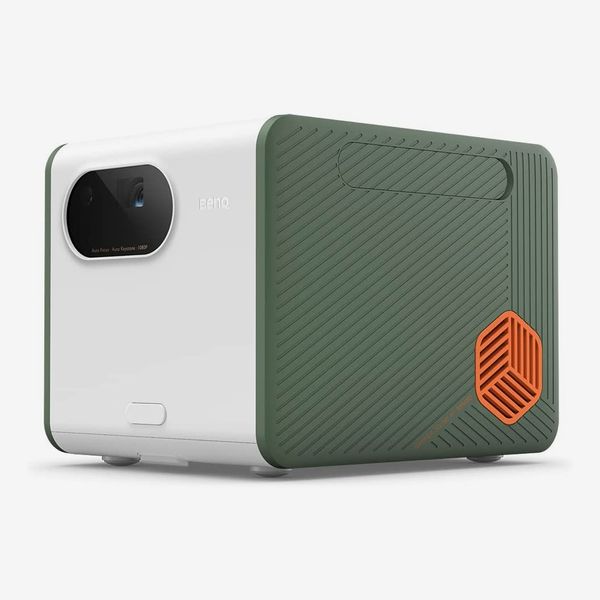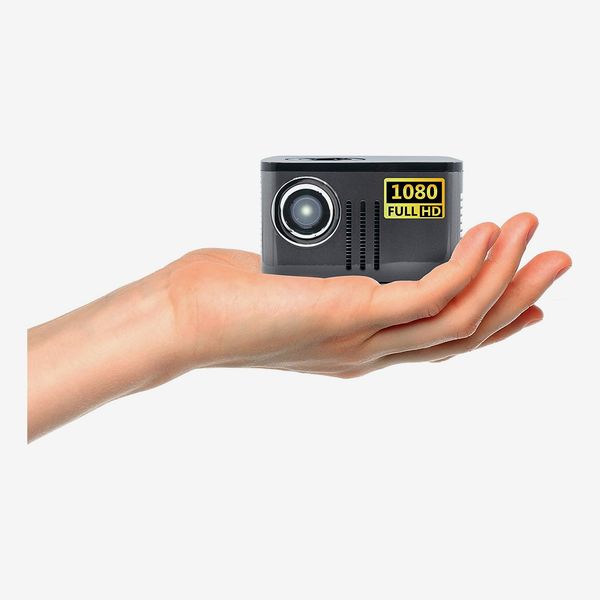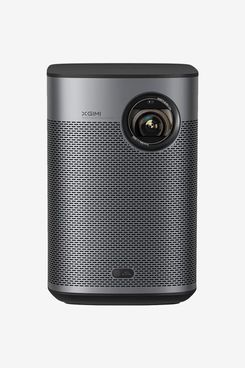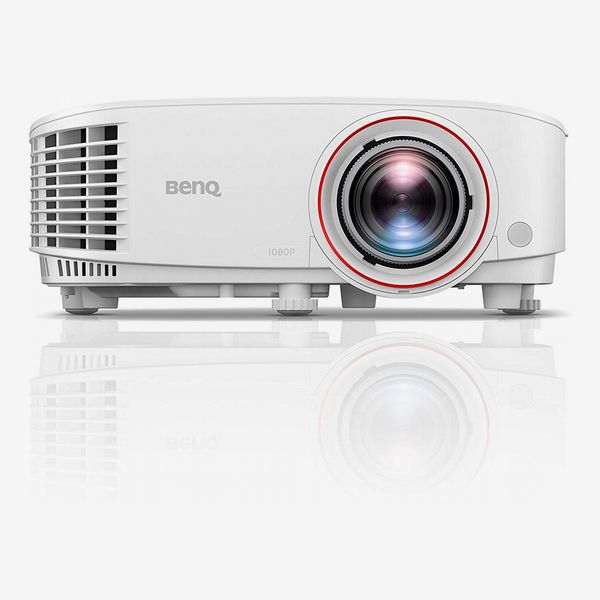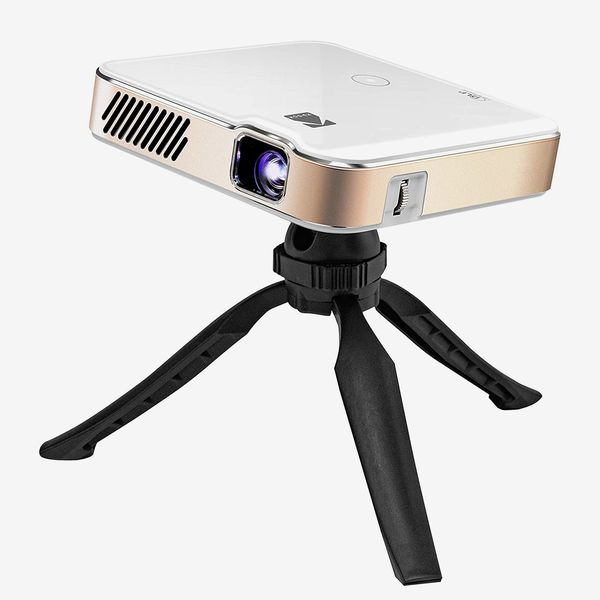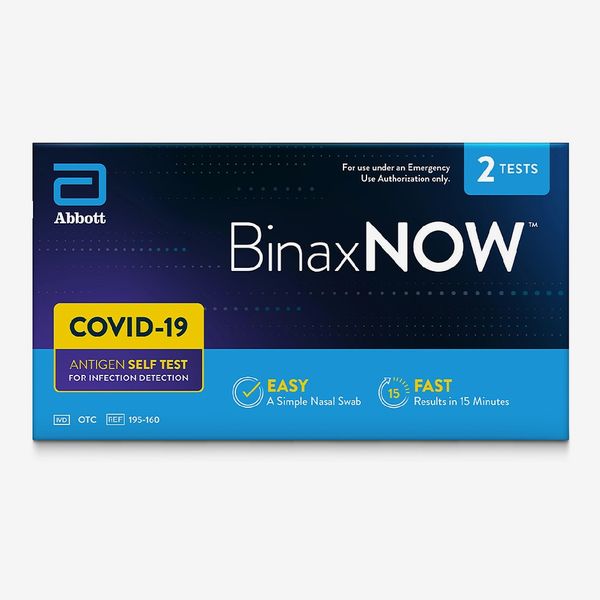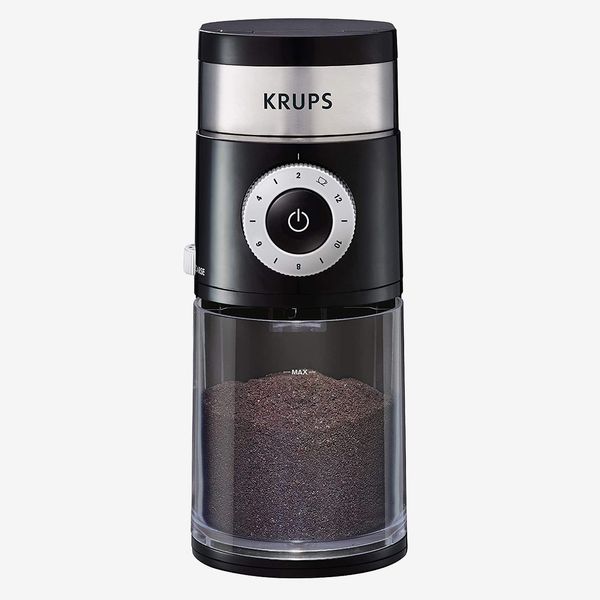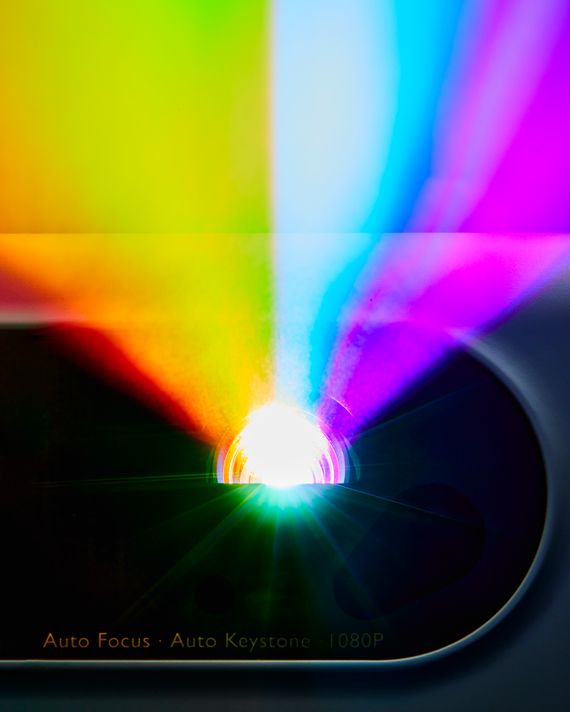
In this article
Portable projectors can give you an instant theater space, and not just at home. Also known as pico or pocket projectors, they are small, typically more affordable than their larger counterparts, and easy enough to move from room to room or bring to a rooftop hang or barbecue. Once they’re connected to a streaming device, laptop, smartphone, or game console via Bluetooth or cables, they can play movies, YouTube videos, or any other type of multimedia (with some limitations due to Digital Rights Management protections; more on that, below). These compact projectors are all about convenience and portability, so they won’t be as bright or sharp as a high-end projector, but for an impromptu movie night indoors or out, they can’t be beat.
To find out what makes a good portable projector stand out, and what to avoid, I spoke with Mark Steinberg, a senior technologist at B&H Photo, as well as Eric Lin, a cinematographer based in Brooklyn. I also looked at reviews from our colleagues at the Verge, and tested a few projectors in my home and outdoors. Here are some of the best portable projectors you can buy online.
What we’re looking for
Brightness
Steinberg says a projector’s brightness, which is measured in lumens (the amount of light emitted), is one of the most important things to look out for in a projector. “Anything less than 500 isn’t usable, it’ll lose all the contrast and black levels with ambient light,” he says, “It’s awful, it’s almost unwatchable.” He also notes that for projectors with built-in rechargeable batteries, the projector won’t shine at full brightness while on battery power, so it’s important to account for that if you’re planning on using it away from an outlet.
When Lin was looking at projectors for a small space in his home, brightness played a key role, as he needed something that would show up against a good deal of ambient light. “Even with 2,000 lumens, once you start calibrating it, the peak brightness goes down,” he says. “If you put it on cinema mode instead of vivid, it drops a lot due to softer elements like contrast. You probably wouldn’t want to watch a movie at peak brightness.” Even if you don’t manually calibrate the picture settings on your projector, switching to a preset mode like cinema (which will provide more accurate color reproduction) can give a better overall picture quality than the standard settings.
Resolution
The resolution of your projector will determine its picture quality. Steinberg says that no matter what, if you’re using a portable projector, its image quality won’t be anywhere near that of a TV. He recommends projectors with at least a 1080p resolution — as all the models on our list have — to make sure you get the best image quality possible. Our previous best overall projector, the Anker Nebula Capsule Max, costs as much as our less expensive pick, but has a lower resolution of 720p, so we have removed it from this guide.
Projector size
Depending on your needs, you may need a projector that’s just small enough to fit in a carry-on to accompany you on work trips, or you might need something smaller to toss in your bag for a weekend camping trip. There are projectors that pack a decent image into a tiny package — some can fit in the palm of your hand — but you’ll trade brightness, battery life, and screen size for that portability. If you’re willing to lug around a projector with a slightly larger footprint, you’ll be able to get a better and brighter image, and it’ll last longer on a single charge when you’re away from an outlet.
Screen size
The brightest and crispest picture won’t matter if it’s too small for you to see. Portable projectors may not be capable of producing screen sizes as large as bigger, more sophisticated projectors, but some can produce images as large as 120 inches (diagonally) from a distance of roughly nine feet. Projectors with a wider range of potential screen sizes will be more versatile in a variety of spaces, but that’s at the expense of some portability.
Connections
If you’re using a laptop or streaming device such as a Roku or Apple TV, a projector with an HDMI port will suffice, as long as you have an HDMI cable. On the other hand, if you’re streaming movies or TV shows from your phone, you’ll need an HDMI connector, as most streaming apps unfortunately have DRM-protection that prevents wirelessly streaming to an external device via something like AirPlay or Chromecast.
Many of the projectors we recommend come pre-installed with an operating system that can download apps like Netflix or Amazon Prime Video, but you’ll have to rely on the projector’s OS being kept up-to-date in order to ensure those will keep working. Currently, many of the devices we recommend are running old versions of Android (8 versus the current 13), and there’s no way to be sure that streaming apps will keep supporting older versions of the operating system. We recommend using an HDMI cable and your phone or laptop instead for fewer issues.
Power source
If the battery can’t get you through an entire movie on a single charge, as can be the case with projectors that have smaller batteries, it won’t matter how easy the projector is to carry from place to place. All of the projectors with rechargeable batteries that we recommend can only be charged via A/C power, so you’ll need to find your way to an outlet eventually.
Ashley Carman, a former senior reporter at the Verge who has reviewed several portable projectors, advises looking for a portable projector that has “a battery with enough capacity to watch a two-hour movie.” To get an idea of how long a projector will last on a single charge, Steinberg says to look at a company’s claimed battery life, which is about two hours for most portable projectors we considered, and subtract half an hour or so if you’re not using minimal brightness settings.
Sound
Most portable projectors come with built-in speakers, but they won’t be as loud as the sound you can get from external speakers. If you do need that extra volume, many portable projectors have the ability to connect to other speakers via cables or Bluetooth.
Best overall portable projector
Brightness: 500 lumens | Resolution: 1920 x 1080 | Projector size: 7.32” x 6.06” x 5.75”, 5.07 pounds | Screen size: up to 100 inches diagonally from 8.7 feet away | Connections: two HDMI, USB-C, USB-A | Power source: A/C, built in rechargeable battery | Sound: two 5W speakers, Bluetooth
For those who need a projector that’s both compact and durable enough to be lugged around, Steinberg recommends the BenQ GS50. At 500 lumens, it’s about the bare minimum brightness you’d want, but its other features make up for that if you’re only using it in dark spaces. It has a charming, outdoorsy look that’s backed by a waterproof and dustproof exterior that’s drop-proof from up to 2.3 feet, and it’s the only projector we recommend that features that kind of protection.
Among all the projectors Steinberg has tested at this size, he says the GS50’s speakers sound the best. It has a 2.1 stereo channel, as well as a dedicated subwoofer, which no other projector we recommend has. This projector can even be used as a Bluetooth speaker when paired with a smartphone. “The sound won’t rock your world, but it’s better than most,” he says. BenQ claims a battery life of up to two hours, but as noted above, it’s closer to 90 minutes in most cases.
The GS50 also has a built-in autofocus that adjusts the image when it gets blurry, which less expensive projectors like the AAXA P7 lack, so you don’t have to fiddle with the lens yourself. Depending on your needs, this projector can produce an image ranging from 80 inches (diagonal) from a distance of 7 feet, up to 100 inches from 8.7 feet, and it’s one of only two projectors we recommend that can project an image from an angle and straighten itself. It has two HDMI ports, one USB-A port, and a USB-C port, and if you leave your cables behind, it has Android TV built in so you can stream directly from apps, as long as you’ve got a hotspot or wireless network nearby.
According to Steinberg, for many companies, portable projectors are often an afterthought since they’re such a niche market, but that’s not the case with the GS50. It’s the only projector we recommend that comes with a 3-year warranty (most come with a single year). “They’re showing a lot of their experience with this. they were not looking for something that was just a throwaway item,” he says.
Best (less-expensive) portable projector
Brightness: 600 lumens | Resolution: 1920 x 1080 | Projector size: 4.7” x 4.4” x 2.7”, 1.4 pounds | Screen size: up to 120 inches diagonally from 7.5 feet away | Connections: two HDMI, USB-C, and mini VGA | Power source: A/C, optional rechargeable battery | Sound: 2W speaker, Bluetooth
The AAXA P7 isn’t just cheaper than the BenQ GS50; it’s also significantly more portable. It’s small enough to fit in the palm of your hand, and it’s brighter than the larger GS50 (600 lumens, compared to the GS50’s 500), though AAXA notes that when running on battery the brightness drops down to 450 lumens.
Despite its tiny size, the P7 packs a resolution of 1080p, and can project a screen size of 120 inches from up to 7.5 feet away. Unlike the BenQ GS50 or XGIMI Halo+, the P7 doesn’t have any autofocus features or smart TV software onboard, and its battery life tops out at 90 minutes according to AAXA, but Steinberg says that’s a necessary sacrifice for such a small projector at this price point. It’s the only model with a rechargeable battery that isn’t included, though, and it’s an extra $30. On the plus side, however, because the P7’s battery is swappable — the other models we recommend with rechargeable batteries have the built-in kind — you can get an extra one to extend runtime.
The P7 has inputs for HDMI, USB-C, and mini VGA, plus ports for a microSD card and a USB-A flash drive. It also comes with a small tripod you can mount the projector on, but as with the Halo+, it’ll work with any standard tripod if you need more height flexibility. Like the other models on this list, there’s a built-in speaker, but you can also connect it to your favorite Bluetooth speaker for better and louder sound — given the P7’s tiny size, there should be room in your bag for a decent speaker.
Best portable projector for bright environments
Brightness: 900 lumens | Resolution: 1920 x 1080 | Projector size: 4.4” x 4.7” x 6.7”, 3.5 pounds | Screen size: up to 120 inches from 10.46 feet away | Connections: two HDMI, USB-A | Power source: A/C, built-in rechargeable battery | Sound: two 5W speakers, Bluetooth
Steinberg says that, as with BenQ, portable projectors aren’t an afterthought for XGimi. The Halo+’s overall footprint is smaller than the GS50’s, and its brightness is nearly double at 900 lumens, but it has the same 1080p resolution. Its built-in 59W battery should provide about two and a half hours of runtime according to XGIMI, which is much longer than the other battery-powered options we recommend, and like the GS50, the Halo+ can be used as a Bluetooth speaker.
Also like the GS50, the Halo+ comes with Android TV, as well as software that can autofocus and detect obstacles obstructing the image, and adjust the placement of the image accordingly. That software can also automatically align the screen with the surface it’s projecting onto when placed at an angle. The Halo+ is capable of projecting a screen size of up to 120 inches from 10.46 feet away, and can also be placed as close as 5.2 feet for a 60-inch screen size — which is a wider range than the other models we considered. Like the P7, you can also attach the Halo+ to a tripod.
Although its brightness gives the Halo+ an edge over the BenQ, it’s missing two things that make the GS50 stand out: The Halo+ isn’t nearly as durable, so you’ll have to be more careful when lugging it around, and its warranty is only one year.
Best portable projector for small apartments
Brightness: 3,000 lumens | Resolution: 1920 x 1080 | Projector size: 11.6” x 4.7” x 8.8”, 5.9 pounds | Screen size: up to 150 inches from 9 feet away | Connections: two D-sub 15pin (PC-input), 2 HDMI, USB-A, USB-mini | Power source: A/C | Sound: one 5W speaker
If you have a smaller space, don’t plan on carrying your projector out of the house much, and don’t need a rechargeable battery, the BenQ TH671ST offers a bigger screen with substantially more brightness at 3,000 lumens than any other projector we recommend, and it’s still portable enough to move around. Unlike the other models on this list, however, there’s no option to run it off a battery, so you’ll need to be near a power outlet.
In her roundup of the best projectors, former senior video director at the Verge Alix Diaconis says the TH671ST is ideal for people with limited space. It’s significantly larger than the GS50, but in addition to being much brighter, it also has more input options than any other projector we recommend so all your bases are covered, even if you’re connecting it to an old PC.
The TH67IST is also capable of projecting from a slightly farther distance than half of the other projectors we recommend, maxing out at a screen size of 150 inches from a distance of 7.5 to 9 feet away. That’s 50 inches more than our best overall projector, while also providing an extra three inches of distance.
Best portable projector for watching movies in bed
Brightness: 200 lumens | Resolution: 1920 x 1080 | Projector size: 3.1” x 3.1” x 0.87”, 1 pound | Screen size: up to 150 inches from 12.5 feet away | Connections: USB-C (charging and input), USB-A, HDMI, 3.5mm audio | Power source: A/C, built-in rechargeable battery | Sound: two 1W speakers
Although the BenQ TH671ST is small enough to carry from room to room, it’s not quite compact enough to fit into smaller spaces. After a few weeks of testing Kodak’s impressively small Luma 450, it’s been great for both outdoor movie nights and propping up on my nightstand to watch my favorite shows on my ceiling before bed.
Since my bedroom is surrounded by windows, there isn’t much space for a projector’s screen to play a video without looking distorted on an uneven surface. That hasn’t been much of an issue, though, since the Luma comes with a tripod that you can use to angle the projector to point directly upward.
At a maximum brightness of 200 lumens, it’s not quite as powerful as the BenQ GS50, and its speakers aren’t as loud, but nearly all its other specs can go toe to toe with our best overall projector, and it does it in a significantly smaller package. This square-shaped projector is about as wide as a Kindle Paperwhite, though it’s significantly thicker. It’s small enough to toss in a bag for traveling or just moving to a different location, and it won’t take much room on a table or nightstand if you need somewhere to prop it up.
It can project an image of up to 150 inches diagonally from 12.5 feet away, which is actually a bit better than our best overall. From that distance, I was able to play almost all of Sam Raimi’s Spider-Man 2 with a full battery, but had to stop just short of the two-hour mark. That’s not unusual for portable projectors, so you just have to be mindful of what movies you choose (or have a power source nearby).
About cheaper portable projectors
Although you can find a portable projector for under $100 (and a few, like the PVO 300Pro, have gotten popular on TikTok), the savings are not worth the trade-offs. Projectors that cheap won’t have nearly enough resolution to look good from a distance, limiting its flexibility as a portable screen. The PVO 300Pro has a resolution of 800 x 480. That’s significantly lower than any of the other projectors we recommend, and well below Steinberg’s recommendation of sticking to at least a 1080p resolution for an enjoyable viewing experience.
That tracks with my testing: Projectors with a maximum resolution of 1080p look pretty good, even from up to ten feet away, both on the outside wall of my house and the ceiling of my bedroom. A lower resolution screen will look too grainy to be enjoyable. You also won’t be able to wirelessly stream videos from your phone to the projector, and it’ll have a short battery life.
If you want to watch TikToks clearly on your ceiling, you’re better off spending a little extra more for a projector that can produce a better-quality image.
Our experts
• Mark Steinberg, senior technologist at B&H Photo
• Ashley Carman, senior reporter at the Verge
• Eric Lin, cinematographer
• Alix Diaconis, former senior video director at the Verge
The Strategist is designed to surface the most useful, expert recommendations for things to buy across the vast e-commerce landscape. Some of our latest conquests include the best women’s jeans, rolling luggage, pillows for side sleepers, ultra-flattering pants, and bath towels. We update links when possible, but note that deals can expire and all prices are subject to change.
Every editorial product is independently selected. If you buy something through our links, New York may earn an affiliate commission.

